Without life to animate it, to hold it in a characteristic pose or to propel it through the air, a dead bird on the sidewalk can look like a rag or clump of dead leaves. But when I got a little closer to the mystery clump next to the Ciocca Subaru dealership in Gray’s Ferry, across from Stinger Park, it was clear that I was looking at a woodpecker. The mostly black and white bird sported a long, straight beak and bold, scarlet plumage on its throat and the top of its head. I rolled it over and revealed a pale yellow underside. I recognized it as a yellow-bellied sapsucker, so named because it drills holes in tree bark and then drinks the sap that wells up. It was still warm.
The bird died when it smacked into one of the windows above, which reflect the trees across the street in the park. Glass windows haven’t been around long enough for birds to evolve a recognition that what looks like a tree is sometimes an illusion. I found another sapsucker a few yards away at the edge of the street. The two joined the approximately 600 million birds per year that die in the United States by colliding with windows. (On the long list of ways humans kill birds, window collision ranks second only to house cats, which kill about 2.4 billion.)
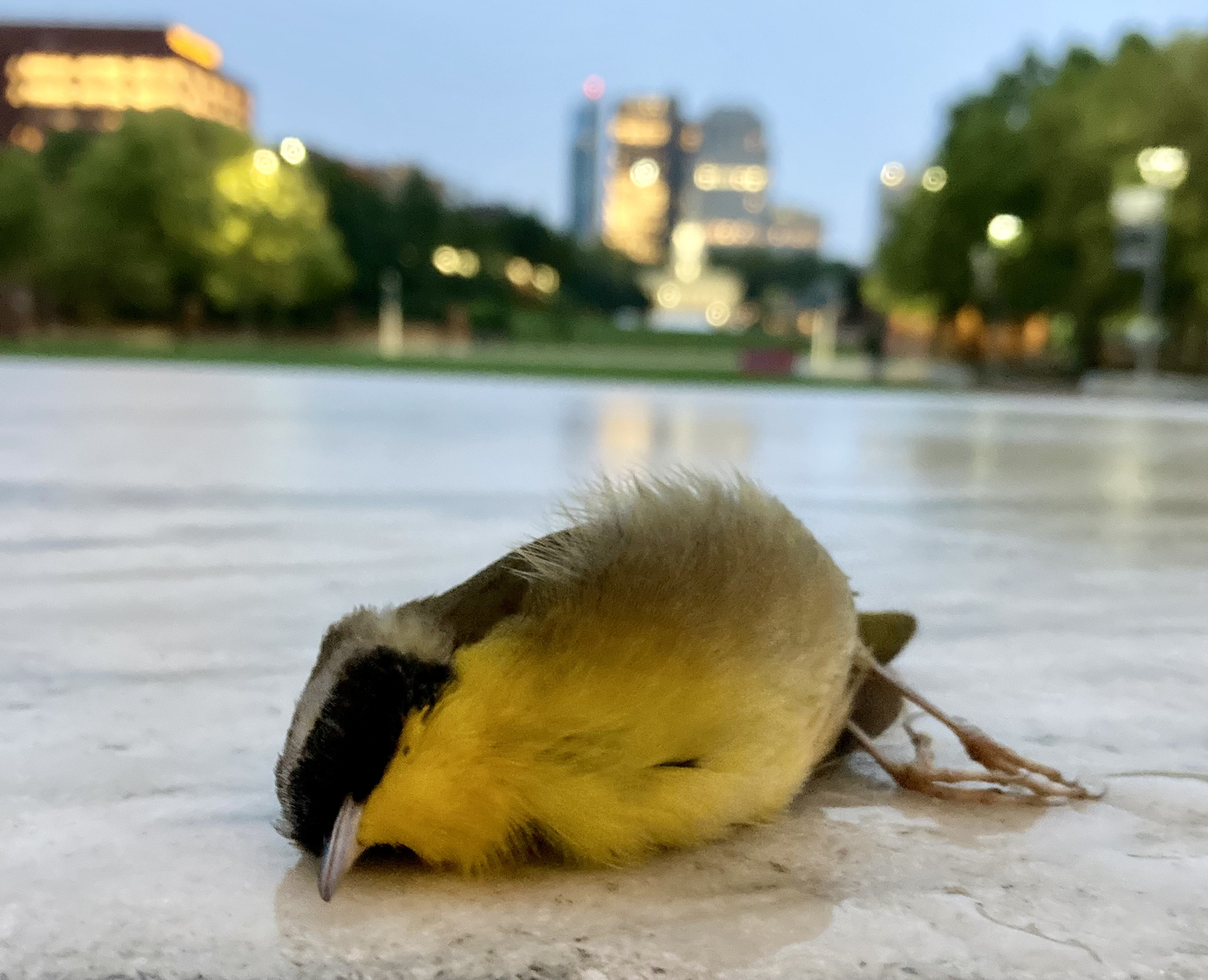
The good news is that we know enough to keep birds like these from running into windows. The question is only whether building owners and architects are willing to implement the practices that will keep these birds alive.
Every spring billions of birds in the Northern Hemisphere fly north from their wintering grounds, which can be as far away as South America. Some will stay in our area, while many more will continue north to the vast forests of Canada and New England. In the fall they reverse their trip.
Virtually all of them spend most of their lives in places without many people, buildings or windows. Songbirds generally fly by night, when they navigate in part by the light of the stars and the moon. The glow of cities can draw them in like moths to a porch light, making them more likely to end up in urban or suburban areas when day breaks, where they face window glass, house cats and other unfamiliar hazards. Particularly bright buildings can utterly confuse them, causing them to fly in circles until they fall to the ground, exhausted.
On October 2, 2020 low cloud cover and a busy night for songbird migration combined to create a massacre in Center City. Stephen Maciejewski, who volunteers collecting data on bird-window collisions, found hundreds of dead birds on his route through the urban canyons. As many as 1,500 birds may have died in total. The event caught the attention of mainstream news media, and it sparked a collaboration among conservation organizations and building owners and managers to try to reduce the carnage. The group, Bird Safe Philly, settled on a simple first request: that building managers turn down their lights on nights during the heart of migration season. In the migration seasons since, volunteer monitors have walked routes through Center City and Old City collecting dead birds and relaying injured birds to wildlife rehabilitation clinics.
Spring 2023 marks the third year of Bird Safe Philly, and the Academy of Natural Sciences has released numbers that tentatively show at least one potential victory, a 70% decrease in dead birds collected at one monitored building, the atrium of the BNY Mellon Center. Annual bird collision numbers can vary, so it will take more years of monitoring to confirm the results, but this is a hopeful sign that turning the lights down helps. “Everyone wants to pat ourselves on the back, but with science you have to do it for a few years,” Maciejewski says.
Of course the lights at night are only one variable in the lethal equation for migrating birds. “Lights out is good when you have skyscrapers with a lot of lights,” Maciejewski says. “If you turn the lights off, then birds might still crash, but you won’t have a mass kill.”
Through the glass facade of the Comcast Technology Center, humans and birds can see ficus trees inside the lobby. “They’ve turned the lights down dramatically,” Maciejewski says. “It looked like a beacon, and many birds crashed into it, and now that’s dropped off.” Grid reached out to Comcast to see if the company had plans to reduce collisions further by making the glass visible to birds. The company’s response noted the lighting changes but did not mention any plans to make the glass more visible.

Large windows are particularly lethal when they reflect greenery, as is commonly the case near parks. In the fall of 2022 a friend of Maciejewski alerted him to dead birds on the sidewalk along the Ciocca Subaru dealership across from Stinger Park. He followed up and found five in one visit, including a golden-crowned kinglet and a white-throated sparrow.
“You can tell at the Constitution Center where the bird hit based on where you find it. The second floor overhangs the first floor, so the ones that hit the first are underneath. The second floor, they sort of bounce off,” says Stephanie Egger, a biologist who has volunteered for two years as a collision monitor around Independence National Historical Park and as a driver for injured birds. She also coordinates other volunteers who monitor around the park. During migrations she walks her route five times in a morning shift lasting from 5:30 to 8:00.
I think it was the first season I was monitoring, we had a scarlet tanager at the Constitution Center. It was so bright and beautiful, and I thought, ‘What a waste.’”
— Stephanie Egger, Bird Safe Philly volunteer
Amid all the birds she has collected, some stand out. “I think it was the first season I was monitoring, we had a scarlet tanager at the Constitution Center,” Egger says. “It was so bright and beautiful, and I thought, ‘What a waste.’ These birds are doing what they need to do: migrating, resting, having a stopover. They try to leave, and they end up dying for some reason that’s so preventable.”
Bird Safe Philly volunteers found that the Sister Cities Café, a low glass building in Sister Cities Park near Logan Circle, killed as many birds as some skyscrapers. Architect Jamie Unkefer, partner at DIGSAU, worked on designing the building in the early 2010s. “We had this idea of a very transparent landscape-integrated building, and the glass was a way to give an illusion of being in the park,” Unkefer says. “We didn’t appreciate at the time that birds were flying around down there like that.”
Even smaller glass features that reflect or sit in front of greenery, like bus shelters and glass railings, such as at the Philadelphia Museum of Art’s sculpture garden, can also pose a hazard.
Luckily windows can be made much safer for birds by making them visible. Research by ornithologists, much of it done by Daniel Klem at Muhlenberg University, has demonstrated that birds will mostly avoid flying through a tight pattern leaving spaces no more than two inches vertically and four horizontally. The pattern can be stuck onto the outside of the glass, or it can be built in with opaque coatings baked onto the glass (fritted) or patterns etched into it.
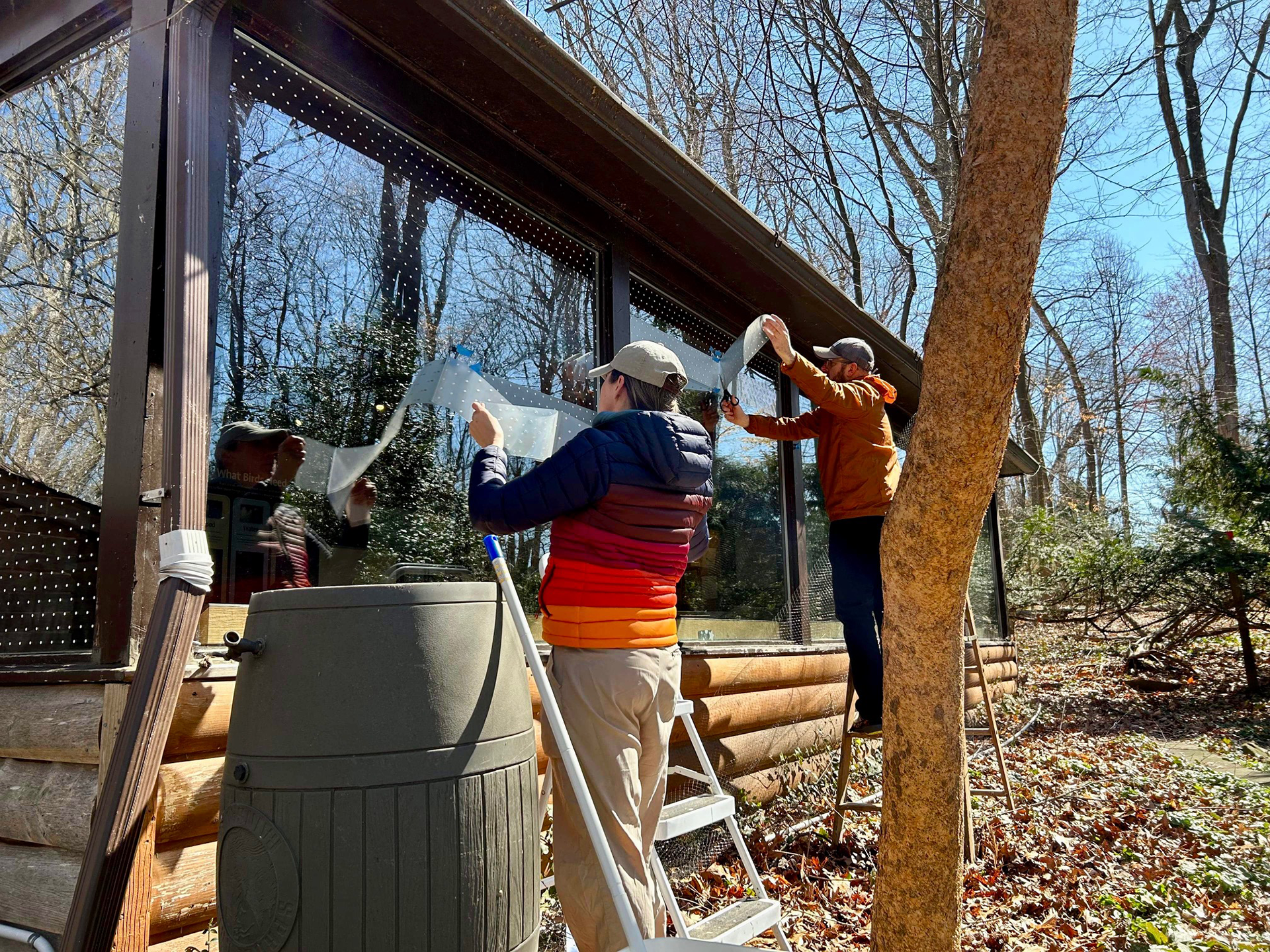
Unkefer attributes his current understanding of bird-window collisions to his firm’s work on the Discovery Center at the East Park Reservoir, managed by Audubon Mid-Atlantic and Outward Bound. The building, which opened in 2018, is a showcase of bird-friendly windows. “Working with experts like Keith Russell [a local Audubon ornithologist] introduced it as a more expansive topic. It’s been a slow evolution that really came to its full realization through the Discovery Center.”
Egger helped apply window films at Briar Bush Nature Center’s bird observatory building, which had large windows facing bird feeders. Egger has also started working with her daughter’s elementary school, Springside Chestnut Hill, to add a pattern to windows at the school that face the greenery of the Wissahickon.
According to Chloe Cerwinka, landscape planner at the University of Pennsylvania, the Bird-Friendly Penn initiative has guided the university to design new buildings with bird-friendly glass and to retrofit others. Joe Durrance, who has monitored bird-window collisions on campus since 2013, found concentrations of dead birds below both a glass walkway at the veterinary school and windows of the medical school’s Johnson Pavilion. Patterned window films applied in 2015 and 2016 cut bird deaths dramatically. At the veterinary school’s walkway, 11 dead birds were found in the spring before the retrofitting. Only one was found in the fall following the work.
I feel like a war correspondent. I can’t stop the war, but I can document the casualties and hopefully enlist more people to stop it.”
— Stephen Maciejewski, Bird Safe Philly volunteer
In Franklin Square the new PATCO station entrance will feature bird-safe glass. “PATCO explored the possibility of bird collisions during the project’s design phase,” says PATCO spokesperson Mike Williams. “As a result, a fritted pattern on the glass was incorporated into building specifications.”
According to Center City District spokesperson JoAnn Loviglio, “Center City District will be partnering with Bird Safe Philly on a ‘feather friendly design’ for the Sister Cities Park Café.”
Eric Narodovich, general manager at Ciocca Subaru, says the dealership is “actively working on trying to find a solution. We’re probably more at the information stage, trying to figure out what’s causing it, what are solutions.”
The National Constitution Center and the Philadelphia Museum of Art did not reply to Grid’s requests for comment about their windows and glass railings.
Although buildings that kill large numbers of birds draw media attention, most birds killed by windows die in residential neighborhoods. One house’s windows might only kill a couple birds per year, but there are a lot of house windows in North America. Egger ended up adding a pattern to the windows of her home in Manayunk. “I feed birds, and my partner said a downy woodpecker bounced off the window. I said, ‘What?’ and did my own house.”
Bird Safe Philly is still in its early stages, and Maciejewski sees preventing bird-window collisions as a campaign that will take decades to be successful. “I think of what we accomplished with lead paint or cigarette smoking,” he says. He says he hopes more people sign up as volunteers. “I feel like a war correspondent. I can’t stop the war, but I can document the casualties and hopefully enlist more people to stop it.”
New York City Council passed legislation to require bird-friendly glass citywide, but until Philadelphia passes something similar, Unkefer sees a role for architects in keeping birds from flying into windows by raising the issue with clients. “We do it with life safety issues all the time. We say, ‘People are going to fall off this ledge. We need a railing.’ We could say, ‘Birds are going to fly into this and die. We should do something to mitigate it.’”
bird safe philly is looking for more volunteers to monitor buildings for birds that have flown into windows and to drive injured birds to wildlife rehabilitation clinics. Email birdsafephilly@gmail.com to get involved.


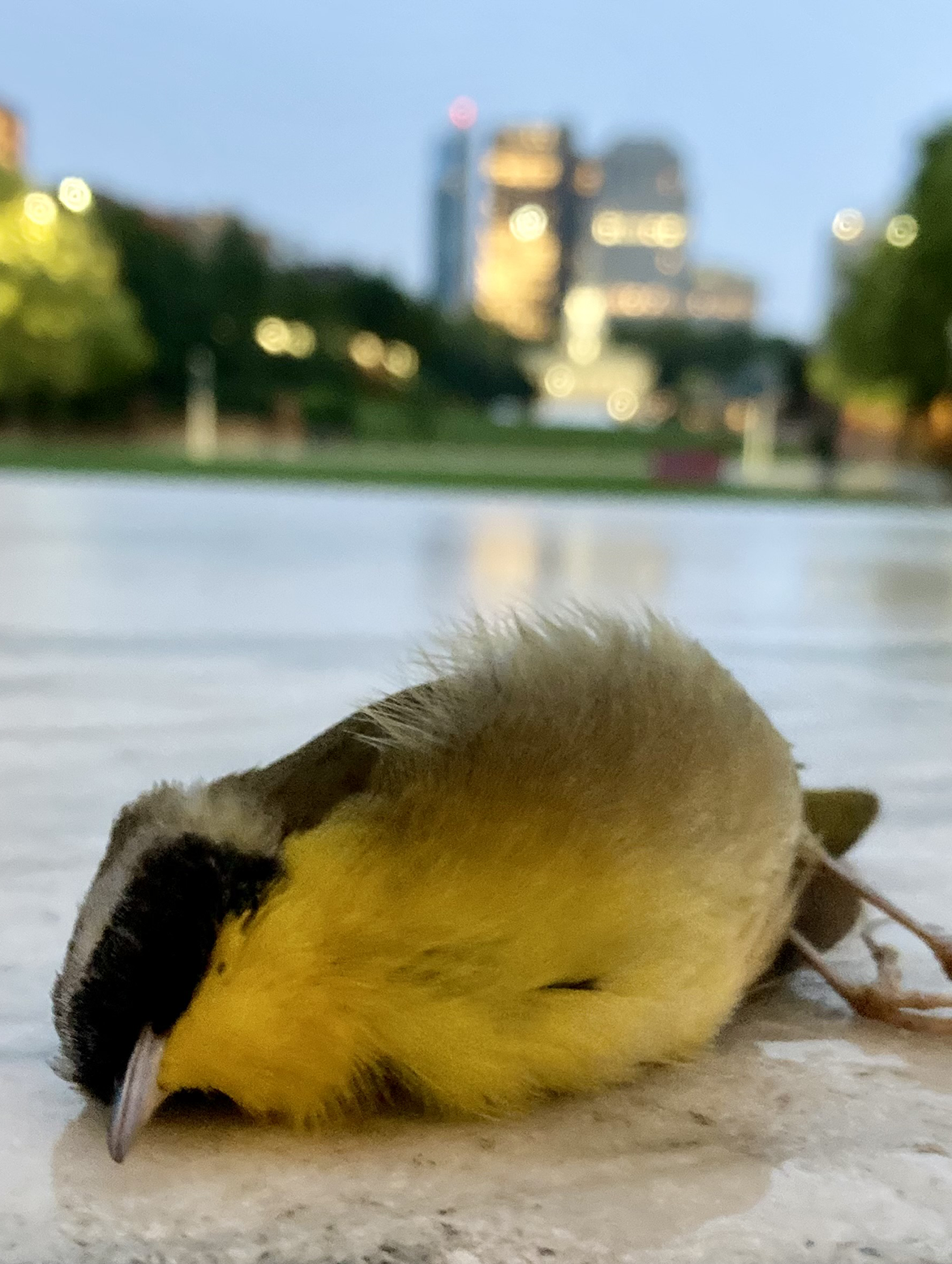
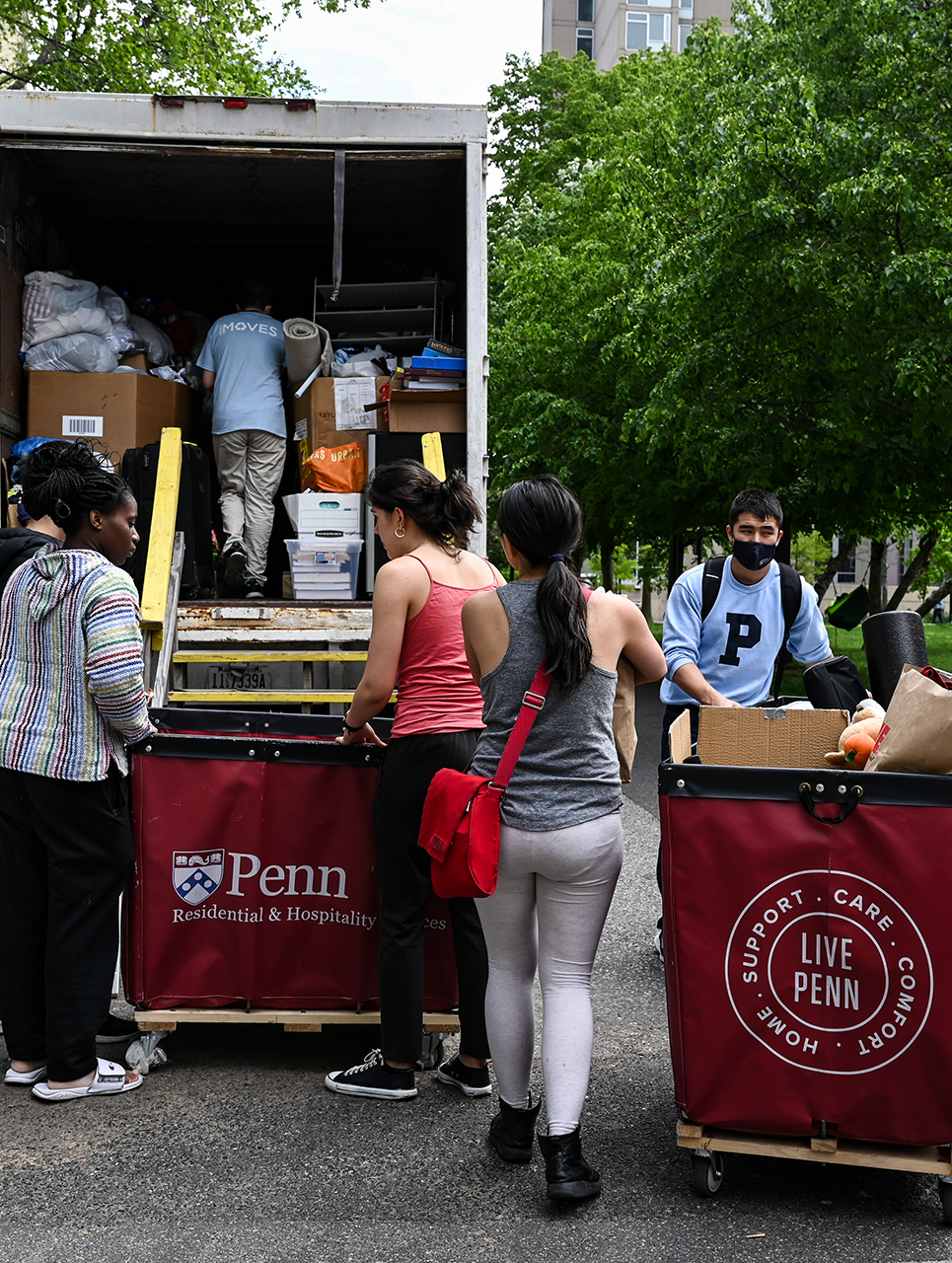

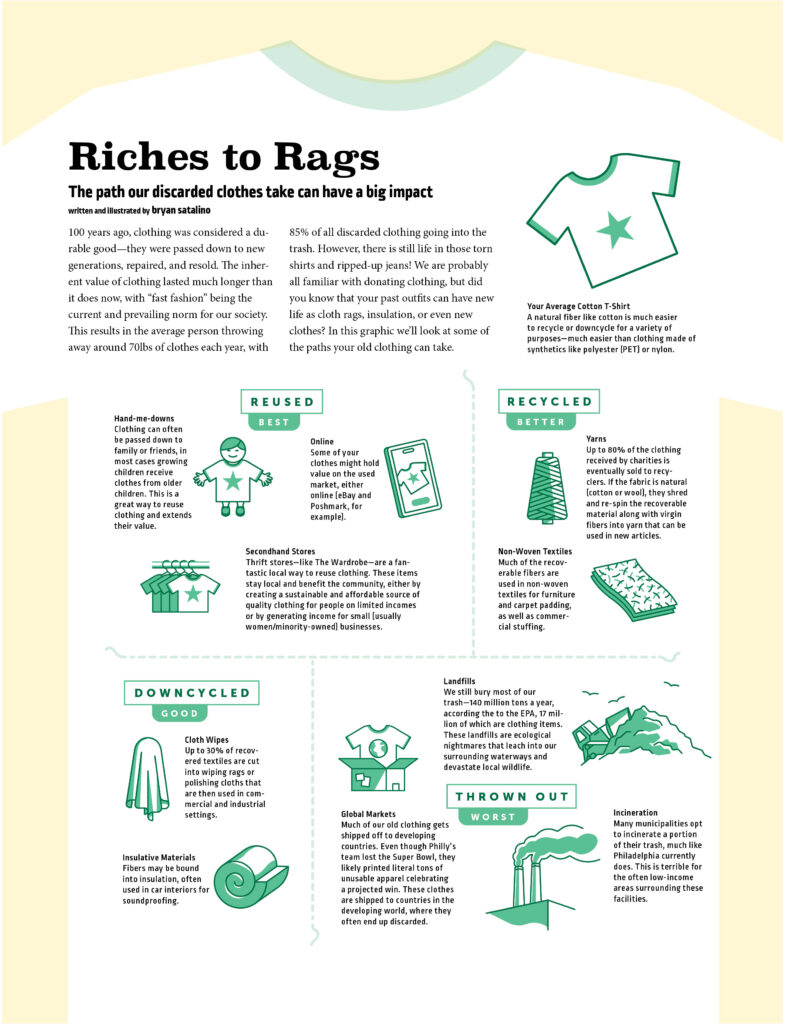
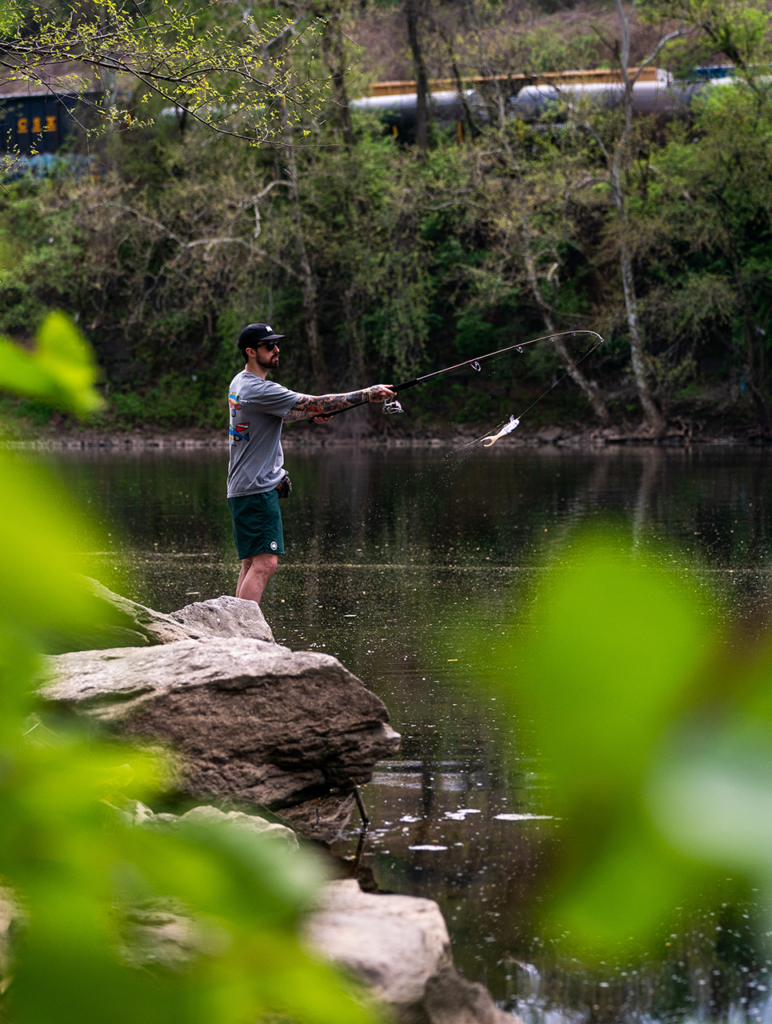


My cheap and easy fix for crashes into small and average house windows: 1/4 inch curling ribbon, lightly curled and taped in place at the top and bottom so it’s a bit on the loose side, It has successfully prevented bird crashes for decades. I use white or yellow. and space about every 5 inches, 3 strips per pane. It may work just because the window look less like a place they can fly through.
Thank you for all you do.
It would be nice in articles about this insidious killer to mention the devoted Ornithologist who about 50 years ago devoted his life to educating people about, and finding ways to solve this problem. He is the world’s leading researcher on the bird-window collision issue, and my good friend, Dr. Daniel Klem, Jr. He has fought tirelessly to combat a problem that most people turn a blind eye to. He is a hero, and desrvedly so. He even holds a patent on a way to manufacture glass that is visible to birds, yet remains invisible to humans. Yet glass companies haven’t or won’t use it. It is a mystery to Dr. Klem, myself, and many others involved in solving this avoidable problem. In the mean time, please use mitigation techniques on your glass. We owe it to the birds. They were here first.
Thanks for mentioning Dr. Klem. A few years back I did an another article on bird-window collisions, and I interviewed him for that (https://gridphilly.com/blog-home/2014/05/21/when-art-and-birds-dont-collide-local-colleges-use-student-w-html/). For this month’s article I ended up with so much more than I could include in the article, and I wanted to focus on what’s happening with buildings in Philadelphia. Again, thanks for reminding us about Dr. Klem’s contributions – his research is the core of what we’re seeing in the buildings adopting bird-safe window solutions.